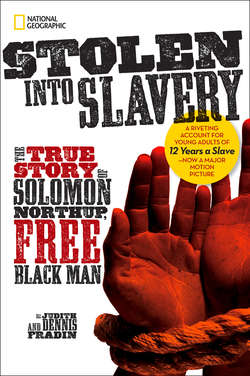Читать книгу Stolen into Slavery: The True Story of Solomon Northup, Free Black Man - National Kids Geographic - Страница 7
(Illustration Credits 1.2)
ОглавлениеSOLOMON NORTHUP AWOKE IN THE MIDDLE OF AN April night in 1841 with his body trembling, his head throbbing, and a terrifying question in his mind: Where was he? He slowly realized that he was in a dark, dank, foul-smelling dungeon in Washington, D.C. Worse yet, he was in handcuffs and his feet were chained to the floor.
As his head cleared, Solomon managed to slip a hand into his trousers pocket, where he had placed his money and his “free papers” for safekeeping. They were gone! He checked his other pockets and found no trace of the money or the papers that proved he was one of 400,000 “free blacks” in a nation where 2.5 million African Americans were slaves.
“There must have been some mistake,” Solomon told himself. Any second now the two white men he had been traveling with would arrive to free him. But as the night wore on, he began to wonder whether these seemingly friendly men could have betrayed him.
The rising sun revealed that Solomon was in a cell with only one small window covered by thick iron bars. Soon he heard footsteps coming down the stairs. A key turned in a lock, the heavy iron door swung open, and two men entered the room where Solomon was chained.
“Well, my boy, how do you feel now?” asked one of the men, who Solomon later learned was named James Birch.
Solomon, who was 32 years old, wasn’t accustomed to being called “boy,” which was a demeaning way of addressing male slaves regardless of age. “What is the cause of my imprisonment?” Solomon demanded.
“I have bought you, and you are my slave,” said Birch, adding that he planned to send him far south to New Orleans to be sold.
“I am a free man, a resident of Saratoga Springs, New York, where I have a wife and children who are also free, and my name is Northup!” Solomon protested. Furthermore, he vowed, once he was liberated from this hellhole he would prosecute Birch for kidnapping.
Birch was enraged. He called Solomon a “black liar” and insisted that he was a runaway slave from Georgia. As Solomon continued to assert that he was a free black man from New York, Birch ordered his assistant to bring him his paddle and whip. Ripping off Solomon’s shirt, the assistant stood on his chains to pin him to the floor while Birch beat him with the paddle. From time to time Birch paused to ask whether Solomon still claimed that he had been free. Despite the intense pain, Solomon refused to say that he was a slave.
When the paddle broke, Birch picked up his whip. Soon streams of blood were pouring down Solomon’s back, and strips of skin were gouged out wherever the lash struck. Even so, Solomon still wouldn’t say what Birch demanded—that he was a fugitive slave from Georgia.
After a quarter of an hour Solomon was barely conscious and Birch’s right arm was exhausted. As he put down his whip, Birch warned Solomon, “If you ever utter again that you are entitled to your freedom or that you have been kidnapped, the punishment you have just received is nothing compared with what will follow!” Birch and his assistant then departed, slamming the big iron door behind them.
Paddling was one of many methods used by owners to humiliate and control their slaves. This scene is set in the West Indies, but Solomon Northup suffered the same punishment in Washington, D.C. (Illustration Credits 1.3)
Solomon had been beaten so savagely that for a few days he expected to die. His handcuffs and leg chains were removed but the pain from his injuries made movement difficult. His only contact with the outside world came twice a day when the assistant brought him a tin plate containing a piece of fried pork, a slice of bread, and a cup of water.
When he had healed enough to walk, he was allowed to exercise in the yard with several other black prisoners in the building. One man whom he befriended, Clemens Ray, informed him that they were in a “slave pen”—a kind of prison where James Birch held his slaves before sending them down to New Orleans to be sold. The slave pen was so close to the U.S. Capitol that Solomon could see the building’s dome from the yard.
This slave pen is similar to the one in which Solomon Northup was held. Each door led to a dark, airless cell. (Illustration Credits 1.4)
Heartsick and furious about being enslaved, Solomon enjoyed peace of mind only when he went to sleep at night. Then he would dream that he was back in Saratoga Springs with his wife and their three children. But he always awakened to the realization that he was imprisoned in a jail cell in Washington, D.C., and, in the darkness, he would weep bitter tears.
Yet he did have one hope: escape! Fleeing from the slave pen was pretty much out of the question because the building was like a fortress and was surrounded by a tall, brick wall. But perhaps the trip to New Orleans would offer an opportunity to break free from this nightmare.
